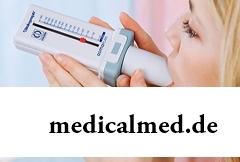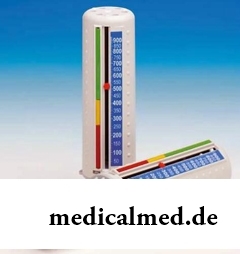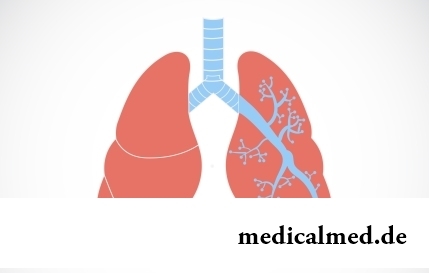





Pikfloumetriya
 Pikfloumetriya (English Peak Flow) – a method of functional diagnosis for determination of peak volume speed of the forced exhalation. In other words this method helps to estimate with what speed of people air can exhale, and thus estimate extent of obstruction (narrowing) of respiratory tracts. Pikfloumetriya is very important for patients with bronchial asthma and a chronic obstructive pulmonary disease, she allows to estimate efficiency of the carried-out therapy.
Pikfloumetriya (English Peak Flow) – a method of functional diagnosis for determination of peak volume speed of the forced exhalation. In other words this method helps to estimate with what speed of people air can exhale, and thus estimate extent of obstruction (narrowing) of respiratory tracts. Pikfloumetriya is very important for patients with bronchial asthma and a chronic obstructive pulmonary disease, she allows to estimate efficiency of the carried-out therapy.
For this method of a research there is a special device – пикфлоуметр which represents a compact tubule with the graduated scale. The modern device is convenient and simple in use, with its help the patient can independently control the state, calculate a dosage of the accepted drugs and warn a suffocation attack. Pikfloumetra happen both for adults, and for children. As a rule, children can use the device from 4-6 years.
The patient independently conducts a research twice a day, and enters all indicators of a pikfloumetriya in the schedule by means of which it is possible to understand better features of a course of bronchitis and asthma.
Carrying out pikfloumetriya
The procedure becomes in a sitting position (or standing). At first it is necessary to make several quiet breaths and exhalations then the deep breath is taken, the mouthpiece of a pikfloumetr is densely clasped with lips and the deep forced exhalation is made. At the same time it is necessary to discipline the device parallel to a floor surface. For each session it is required to make not less than 3 exhalations through some periods (2-3 min.) and to choose the maximum value.
 Pikfloumetriya is carried out not less than 2 times a day – in the evening and in the morning. In case of selection of new therapy it is necessary to make a research three times a day. All indicators of a pikfloumetriya register in the diary or are noted on special schedules (which are attached complete with the device).
Pikfloumetriya is carried out not less than 2 times a day – in the evening and in the morning. In case of selection of new therapy it is necessary to make a research three times a day. All indicators of a pikfloumetriya register in the diary or are noted on special schedules (which are attached complete with the device).
Assessment of results of a pikfloumetriya
Norms of indicators of a pikfloumetriya are calculated individually for each patient, depending on his sex, age and growth. For children only the age is considered. At the beginning of use of this device within 3 weeks the individual chart with three color zones is formed. For this purpose the condition of the patient has to be stable – without bronkhoobstruktion signs. At achievement of the maximum result by it (which have to be brought closer to norm) it is multiplied by coefficient 0.8 – for example if the maximum indicator of a pikfloumetriya of 400 l/min, then 400 multiply on 0,8. We receive 320 l/min. Value of measurement above this indicator will belong to "a green zone" – that is to the normal level of passability of respiratory tracts. "The yellow zone" is the maximum indicator of a research increased by coefficient 0,5. That is 400 we multiply on 0,5 and we receive 200 ml/min. (it will be the lower bound of a yellow zone). In this case values from 200 l/min to 320 l/min will be borders of "a yellow zone". If the indicator of a pikfloumetriya is in this zone, then it means that correction of the carried-out therapy with participation of the attending physician is necessary. The indicator, less lower bound of "a yellow zone" belongs to "a red zone". If the defined value is in it, then it means that the patient has a serious respiratory insufficiency, and urgent intervention of the doctor is necessary. About an algorithm of actions of the patient at an indicator which is in "a red zone" it is necessary to consult with the attending physician in advance.
Thus, the pikfloumetriya allows to exercise control of a disease of a respiratory organs in house conditions, and it promotes reduction of volume of the used medicines. Use of system of zones allows to see timely approaching danger and to prevent the emergency hospitalization.
In the aspiration to pull out the patient, doctors often go too far. So, for example, a certain Charles Janszen during the period from 1954 to 1994 endured more than 900 operations on removal of new growths.

Each of us repeatedly noticed that the people having the same passport age are sometimes not similar on one-years at all. One...
Section: Articles about health
Obesity is called a disease of 21 centuries, for the last 100 years the number of the people suffering from excess body weight considerably increased. Statistically, on Earth already about 1,5 billion corpulent people, and 500 million from them have extreme degree of completeness, are negative...
Section: Articles about health
Each of us faces from time to time that other people need the immediate help. We react to it differently: one at once call doctors and police, others rush to victims and try to save them independently. Some pass by at all … Certainly, desire to help the neighbor who got into trouble, quite naturally for any decent person. However not everyone understands that to work in a similar situation, being guided by exclusively good...
Section: Articles about health
It is pleasant to state a possibility of improvement of quality of life of people with problems of functioning of secretory system. By efforts that...
Section: Articles about health
The concept "gluten" (differently, a gluten) combines group of the proteins which are a part of rye, barley and wheat. For most of people the use of the food stuffs containing a gluten not only is safe, but also it is very useful. Nevertheless, there is a number the myth...
Section: Articles about health
They say that to ensure health and longevity of people it is obliged. Really, at competent approach to these questions, minimization of an adverse effect of many factors does not represent a special problem. Practically everyone has an opportunity to play sports, to pick up an optimum operating mode and rest, to adjust healthy food, to refuse addictions. It is more difficult to exclude hit in an organism of harmful substances through a respiratory organs: not all are able to afford to live in the area with хо...
Section: Articles about health
The endocrine system carries out in a human body extremely important role, practically all processes of life activity регулируютс...
Section: Articles about health
Not without reason doctors say that 90% of diseases begin or develop because of misoperation of intestines. Disturbance of its functions is connected with various factors among which the important place belongs to excessive "clutter" of an intestinal path. In an organism скаплив...
Section: Articles about health
Practice of hypnotic impact on consciousness of the person contains about two millennia. During this time scientists managed to learn a lot of things about a phenomenon of hypnosis and learned to facilitate a condition of the patients having heavy illnesses with its help....
Section: Articles about health
History of use of an anesthesia during operations contains more than 160 years. Annually in the world hundreds of thousands surgical вм are carried out...
Section: Articles about health
80% of women at least once to lives complained of discomfortable feelings to breasts, consolidations and nagrubaniye. These are mastopathy symptoms. The mastopathy is characterized by change of a ratio between ferruterous and connective tissue tissues of mammary glands. It can bring...
Section: Articles about health
The phenomenon of improvement of a condition of the patients at administration of drugs who are not containing active agents, so-called effect of placebo is known long ago. At the end of the 18th century the American doctor Perkins began to treat people the "miracle" sticks made of alloy of steel and brass. Was for several minutes to press such subject enough to a sore point that it became much easier for the patient. Having suspected Perkins of charlatanism, his colleagues tried to repeat "miracle" by means of sticks, steles...
Section: Articles about health
About 20% of the population of our planet have a hypertension (permanent increase in arterial pressure). This disease negatively narrations...
Section: Articles about health
For the last decades the diabetes mellitus of the second type became really world problem. The number of cases annually increases, and average age of patients for whom the illness is diagnosed, steadily decreases. Specialists consider that one of osno...
Section: Articles about health
Work of a brain is extremely complex and in many respects is not studied yet. It is confirmed also by the features of thought processes which are shown when the person sleeps. Let's tell about some of them....
Section: Articles about health
Deciding to get rid of an addiction, not all imagine what effects it is necessary to face. Process of refusal from ку...
Section: Articles about health
It would seem, about it there can be no disagreements: water is necessary for a human body for normal life activity, and about how and when it should be drunk, all know. It turned out that the situation is not absolutely so: for many years occur ве...
Section: Articles about health
According to data of World Health Organization, the cataract is diagnosed almost for 7% of the population of Earth. The statistics of incidence is considered not full as at an initial stage the illness, as a rule, does not cause to the person of special inconveniences, and many diseased sees doctors not at once. The cataract is not only one of the most widespread ophthalmologic illnesses, but also the reason of a half of cases of loss of sight....
Section: Articles about health
Cold is such painful that each sigh becomes a victory, heat "knocks" down, and the ache in joints forces to think only about...
Section: Articles about health
The brain of the person is studied not one hundred years, but the quantity of the riddles connected with this body increases rather, than decreases. Perhaps, numerous delusions concerning a structure and functioning of a brain, many are explained by it from...
Section: Articles about health
The cosmetics intended for improvement of a condition of skin, nails and hair are used by each woman. Expenses on regular acquisition of the fashionable widely advertized products of well-known companies for many become very notable and significantly burden the family budget. Meanwhile, there is a number of inexpensive pharmaceutical drugs which can quite be applied in the cosmetic purposes. At the same time the effect of their use is often more noticeable, than result of use of the most expensive...
Section: Articles about health
Ayurveda - the most ancient tselitelsky practice which came to us from India. It represents the doctrine about maintenance physical, ps...
Section: Articles about health
With age in a human body harmful substances collect. We receive them with food and water, at inhalation of the contaminated air, reception of medicines, use of household chemicals and cosmetics. A considerable part of toxins accumulates in a liver, osnovno...
Section: Articles about health
The next flu epidemic leads to the next panic, from year to year we give in on these manipulations: professionally alarming voice of the announcer in news, reports with calculation of the died patients, an interview with people in white dressing gowns and advertizing of anti-influenza means of different degree of inefficiency. All this reminds the Hollywood movies of epidemics threatening to destroy our planet. However, there is also one more similarity to cinema: everything comes to an end well. So, how to deal with the events, not in...
Section: Articles about health
Life expectancy in various regions of Earth is not identical. Exert impact on it social stability, economic бл...
Section: Articles about health
In consciousness of our many compatriots idea that folk remedies if are no more effective, than medicinal "chemistry" strongly took roots, then are precisely less harmful. Unfortunately, it is not always fair: some receptions treating...
Section: Articles about health
Sooner or later hair turn gray at all. Many people try to hide these changes, returning natural color of the hair by means of coloring, or considerably changing it for the purpose of creation of absolutely new image. All know that the gray hair is a sign of the coming old age, so, it is necessary to get rid of it....
Section: Articles about health
